Blue mussels shed light on munition contaminants in marine ecosystems
24 Jul 2023

A long-term study uncovers trace levels of munition contaminants in blue mussels along the German Baltic and North Sea coastlines, raising questions about the potential long-term impact of these pollutants on marine ecosystems and human health.
Marine environments across the world are facing an insidious threat from discarded munition materials and unexploded ordnances (UXOs), most of which resulted from the First and Second World Wars. These munition relics include fired but unexploded ammunitions – such as bombs, bullets, shells, grenades or mines – or cargo from sunken vessels and downed fighter aircraft.
Enormous quantities of UXOs and dumped military munitions are usually concentrated in hotspots – such as the coastal areas of the North and Baltic Sea in Germany. Many will contain energetic compounds (ECs), such as TNT and its metabolites, which exhibit toxic and carcinogenic properties and have the potential to disrupt surrounding marine ecosystems.
As mussels are filter feeders which actively accumulate contaminants from their surrounding environment, they are commonly used as bioindicators for monitoring pollution in marine ecosystems. Since the 1980s, the German Environmental Specimen Bank (ESB) has regularly collected and archived blue mussels – providing a valuable resource to examine trends in the presence and levels of ECs over time.
Monitoring trends
In a new study, published in Toxics, researchers investigated the occurrence and trends of ECs and their metabolites in blue mussels from the ESB collected over the last 30 years at three different locations along the coastline of the Baltic and North Sea.1
The team used gas chromatography-tandem mass spectrometry (GC-MS/MS) to identify and quantify specific pollutants in blue mussel samples. Targeted compounds included 1,3-dinitrobenzene (1,3-DNB), 2,4-dinitrotoluene (2,4-DNT), 2,4,6-trinitrotoluene (TNT), 2-amino-4,6-dinitrotoluene (2-ADNT), and 4-amino-2,6-dinitrotoluene (4-ADNT).
The scientists detected the first signals indicating trace levels of 1,3-DNB in blue mussel samples collected in 1999 and 2000. In subsequent years, they also found ECs below the limit of detection (LoD), indicating their presence in very low concentrations. However, they started to detect signals slightly above the LoD in samples collected from 2012 onwards. The highest signal intensities of 2-ADNT and 4-ADNT, measuring just below the limit of quantification (LoQ) at 0.14 ng/g d.w. and 0.17 ng/g d.w. respectively, were observed in 2019 and 2020.
The team used ultrapure water generated from an ELGA PURELAB® Flex laboratory water purification system, minimising the risk of introducing contaminants that may affect their results.
Long-lasting impact
These findings reveal that corroding submerged munitions are gradually releasing ECs into the marine environment along the Baltic and North Sea coastlines, with detectable levels in randomly sampled blue mussels. Although the concentrations of these pollutants measured remain in the non-quantifiable trace range, their presence raises concerns about their potential long-term effects on ecosystems and human health.
Long-term monitoring efforts, along with targeted studies focusing on the impacts of ECs on marine organisms and human health, are now needed to investigate the full extent of contamination and potential risks associated with these substances.
Why choose ELGA LabWater
ELGA has been a trusted name in pure and ultrapure water since 1937. Our dedication to ultrapure and pure water is a guarantee that we will continue to provide the best solutions with the best service.
Reference:
- Strehse JS, Bünning TH, Koschorreck J, Künitzer A, Maser E. Long-Term Trends for Blue Mussels from the German Environmental Specimen Bank Show First Evidence of Munition Contaminants Uptake. Toxics. 2023 Apr 7;11(4):347. doi: 10.3390/toxics11040347.
Dr Alison Halliday
After completing an undergraduate degree in Biochemistry & Genetics at Sheffield University, Alison was awarded a PhD in Human Molecular Genetics at the University of Newcastle. She carried out five years as a Senior Postdoctoral Research Fellow at UCL, investigating the genes involved in childhood obesity syndrome. Moving into science communications, she spent ten years at Cancer Research UK engaging the public about the charity’s work. She now specialises in writing about research across the life sciences, medicine and health.
Lab Guide
#e95f47
